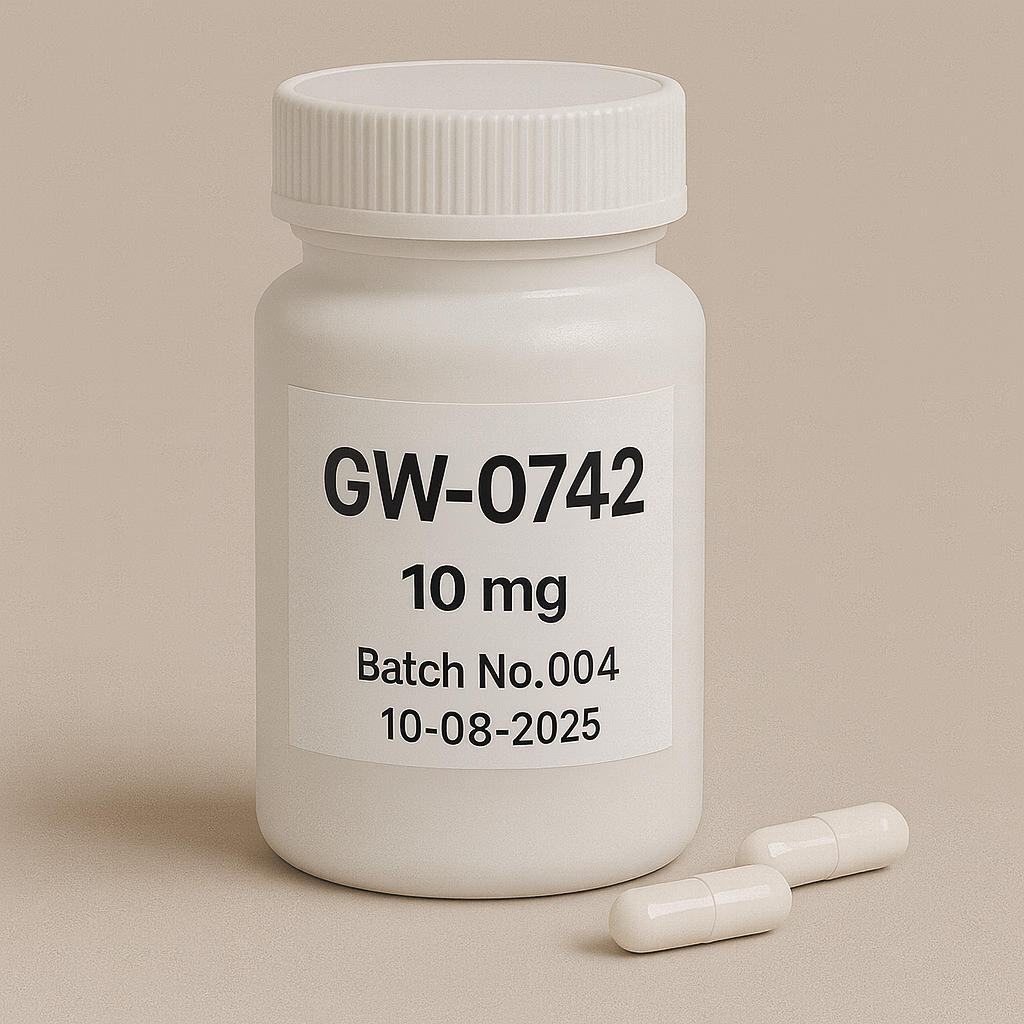
GW0742 100x10mg
Pickup currently not available
NOT FOR HUMAN CONSUMPTION
GW0742 is a highly selective agonist of PPARβ/δ (a nuclear receptor abundant in skeletal muscle, endothelium, liver, and macrophages). Activation upshifts fatty-acid oxidation (FAO) and mitochondrial programs (PGC-1α), improves insulin sensitivity, and exerts anti-inflammatory/vasculoprotective effects via transrepression of NF-κB/AP-1. It is not approved for human use (preclinical tool compound) and PPARδ modulators are prohibited by WADA.
Additional Benefits of GW0742 Now Under Investigation
| Benefit | Key take-aways |
|---|---|
| 1 Endurance & muscle metabolic reprogramming | Up-regulates CPT-1, PDK4, UCP3, shifts fibers toward oxidative/type I phenotype; improves time-to-exhaustion in rodents—an “exercise-mimetic” signature. |
| 2 Insulin sensitivity | Enhances glucose tolerance/HOMA-IR, increases muscle FAO, and reduces lipotoxic intermediates in diet-induced obesity models. |
| 3 Atheroprotection & lipids | Promotes cholesterol efflux (ABCA1/ABCG1), lowers TG/non-HDL, and reduces vascular inflammation; smaller plaques in hyperlipidemic mice. |
| 4 Endothelial function | Increases eNOS/NO bioavailability, lowers VCAM-1/ICAM-1, improving microvascular responses in models. |
| 5 NAFLD/MASH signals | Decreases hepatic steatosis via ↑ β-oxidation and ↓ DNL; lowers ALT/AST and inflammatory transcripts in preclinical liver disease. |
| 6 Anti-inflammatory in gut/systemic | Restraints NF-κB cytokines (TNF-α, IL-6); ameliorates colitis severity with better barrier proteins. |
| 7 Renal protection | Mitigates ischemia–reperfusion and diabetic-nephropathy injury via mitochondrial preservation and anti-fibrotic signaling. |
| 8 Pulmonary hypertension/fibrosis | Lowers RV pressure and vascular remodeling in PAH; attenuates TGF-β–drivenfibroblast activation. |
| 9 Neuroprotection (preclinical) | Improves neuronal mitochondrial function, reduces microglial cytokines, benefits motor/cognitive readouts in toxin/aging models. |
2. Molecular Mechanism of Action
2.1 Receptor pharmacodynamics
-
PPARβ/δ–RXR heterodimer → PPRE transcription of FAO/mitochondrial genes (PGC-1α, CPT-1, ACO, UCP3).
-
Transrepression: Interferes with NF-κB/AP-1 → ↓ inflammatory gene expression (COX-2, TNF-α).
-
Macrophages: ↑ ABCA1/ABCG1 efflux; M2-like shift.
-
Endothelium: ↑ eNOS, ↓ adhesion molecules → vasoprotection.
2.2 Down-stream biology
| Pathway | Functional outcome | Context |
|---|---|---|
| FAO/PGC-1α program | ↑ Oxidative metabolism, endurance | Skeletal muscle |
| ABCA1/ABCG1 | ↑ Cholesterol efflux, ↓ foam cells | Atherogenesis |
| NF-κB/AP-1 restraint | ↓ Cytokines/adhesion | Vascular & gut |
| eNOS activation | ↑ NO, endothelial function | CV system |
| Anti-fibrotic (TGF-β axis) | ↓ Collagen deposition | Kidney/lung/heart |
3. Pharmacokinetics (preclinical)
-
Route: Oral in animal studies.
-
Exposure: Hours-scale half-life in rodents; species-dependent bioavailability.
-
Metabolism: Likely hepatic oxidation; human PK unknown.
4. Evidence Summary
-
Metabolic disease: Consistent insulin-sensitizing and anti-steatotic effects with improved muscle FAO/glucose uptake in rodents.
-
Cardiovascular: Reduced atherosclerotic plaque, improved endothelial function, anti-remodeling post-injury.
-
Renal/pulmonary/gut/CNS: Protection across models via mitochondrial and anti-inflammatory mechanisms.
Evidence quality note: Strong mechanistic + animal data; no peer-reviewed human efficacy trials with GW0742.
5. Emerging Clinical Interests (conceptual)
| Field | Rationale | Status |
|---|---|---|
| Obesity/insulin resistance | Muscle FAO & metabolic flexibility ↑ | Preclinical |
| Atherosclerosis prevention | Efflux + anti-inflammatory | Preclinical |
| NAFLD/MASH | Anti-steatotic + anti-inflammatory | Preclinical |
| PAH/fibrosis | Vascular & fibroblast modulation | Preclinical |
| IBD | Barrier + cytokine restraint | Preclinical |
| Neurodegeneration | Mitochondrial/anti-inflammatory | Preclinical |
6. Safety & Tolerability
-
Human safety: Unknown.
-
Class concern: Another PPARδ agonist (GW501516) produced rodent tumorigenesis at high exposures/long durations; though GW0742 differs, long-term oncogenic risk is unresolved for the class.
-
Metabolic drift: Likely HDL↑/TG↓ benefits; off-target hepatic/lipid effects at supraphysiologic doses possible.
-
Sport/anti-doping: PPARδ agonists are banned; detection programs exist.
-
Drug interactions: Potential nuclear-receptor/CYP/transporter cross-talk—uncharacterized clinically.
Comparative matrix
| Feature | GW0742 (PPARδ) | GW501516 (PPARδ) | Fenofibrate (PPARα) |
|---|---|---|---|
| Human approval | No | No | Yes |
| Selectivity | High for δ | High for δ | α |
| Endurance/FAO | Strong (preclinical) | Strong (preclinical) | Mild (liver-centric) |
| Tumor signal (rodent) | Unknown | Present | None δ-class |
7. Regulatory Landscape
-
Status: Preclinical research tool; not a medicine or supplement.
-
WADA: Prohibited (metabolic modulators).
8. Practical Take & Future Directions
-
Today: Laboratory mechanistic studies only; not for human self-use.
-
Needed next: Drug-like δ-agonists with safety windows, GLP tox/carcinogenicity, and PoM/PoC trials using metabolic and vascular endpoints plus omics/biopsy markers.
-
Opportunities: Tissue-targeted or biased PPARδ modulators to capture FAO/mitochondrial gains while minimizing proliferative risk.
Selected References
-
Muscle oxidative switch & FAO gene programs (PPARδ/PGC-1α): Cell Metabolism; Nature Medicine.
-
PPARδ in insulin resistance & NAFLD: Hepatology; Gastroenterology.
-
Vascular/endothelial protection & atherogenesis: Circulation; ATVB; JCI.
-
Colitis/IBD and anti-inflammatory effects: Gut; PNAS.
-
Renal, pulmonary, and cardiac remodeling models: Kidney Int; Am J Respir Crit Care Med; Cardiovasc Res.
-
WADA/anti-doping overview: Drug Testing & Analysis; WADA Code.


